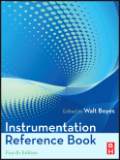
Instrumentation embraces the equipment and systems used to detect, track and store data related to physical, chemical, electrical, thermal and mechanical properties of materials, systems and operations. While traditionally a key areawithin mechanical and industrial engineering, it also has a strong presence in electrical, chemical, civil and environmental engineering, biomedical and aerospace engineering. The discipline of Instrumentation has grown appreciably in recent years because of advances in sensor technology and in the inter-connectivity of sensors, computers and control systems. In turn, this has meant that the automation of manufacturing, process industries, and even building and infrastructure construction has been improved dramatically. And now with remotewireless instrumentation, heretofore inaccessible or widely dispersed operations and procedures can be automatically monitored and controlled.. The new 4thedition of this already well-established reference work, will reflect these dramatic changes with improved and expanded coverage of the both the traditional domains of instrumentation as well as the cutting edge areas of digital integration of complex sensor/control systems. Thoroughly revised, with up-to-datecoverage of wireless sensors and systems, as well as nanotechnologies role inthe evolution of sensor technology. Latest information on new sensor equipment, new measurement standards, and new software for embedded control systems, networking and automated control. Three entirely new sections on Controllers, Actuators and Final Control Elements; Manufacturing Execution Systems; and Automation Knowledge Base. Up-dated and expanded references and critical standards INDICE: Prefaces. List of Contributors. Introduction. Part 1: The Automation Knowledge Base. 1. The Automation Practicum. 2. Basic Principles. 3. Measurement methods, reliability and asset management. 4. Training and Education. 5.Maintenance and repair.. Part 2: Mechanical Measurements. 1. Measurement of Flow. 2. Measurement of Viscosity. 3. Measurement of Length. 4. Measurement of Strain. 5. Measurement of Level and Volume. 6. Vibration. 7. Measurement of Force. 8. Measurement of Density. 9. Measurement of Pressure. 10. Measurement ofVacuum. 11. Particle Sizing. 12. Fiber optics in sensor instrumentation. 13. Nanotechnology for sensors. 14. Microprocessor-based and intelligent transmitters. 15. Wireless sensors and networks. Part 3: Measurement of Temperature andChemical Composition. 1. Temperature measurement. 2. Chemical Analysis- Introduction. 3. Chemical Analysis- Spectroscopy. 4. Chemical Analysis- Electrochemical techniques. 5. Chemical Analysis- Gas analysis. 6. Chemical Analysis- moisture measurement. 7. Chemical Analysis- online systems, NeSSI and sampling techniques. 8. PAT (Process Analyzer Technology initiative). Part 4: Electrical and Radiation Measurements. 1. Electrical measurements. 2. Optical measurements. 3. Nuclear instrumentation technology. 4. Measurements employing nuclear techniques. 5. Non Destructive Testing. 6. Positive Material Identification. 7. Noise measurement. Part 5: Controllers, Actuators and Final Control Elements. 1. Field controllers, hardware and software. 2. Advanced Control for the PlantFloor. 3. Discrete and Sequential Control. 4. Motion control. 5. Cables and connectors. 6. Batch process control. 7. Valves, actuators and final control elements. Part 6: Automation and Control Systems. 1. Design principles and equipment selection for sequential and discrete automation. 2. Design and selectionof field instruments and final control elements for continuous and batch process control. 3. Principles of industrial networking and fieldbuses. 4. SCADA and telemetry systems. 5. Using field controllers, PLCs and PACs. 6. Instrumentinstallation and commissioning. 7. Design principles for control rooms and operator stations. 8. Selecting and specifying a control system. 9. Safety instrumented systems and plant floor safety. 10. Security for the industrial enterprise. Part 7: Manufacturing Execution Systems. 1. Project planning and execution. 2. Modeling the plant floor and the enterprise. 3. Data analysis and connection. 4. Networking for MES. 5. MES-IT integration
- ISBN: 978-0-7506-8308-1
- Editorial: Butterworth-Heinemann
- Encuadernacion: Cartoné
- Páginas: 1312
- Fecha Publicación: 01/04/2008
- Nº Volúmenes: 1
- Idioma: Inglés
